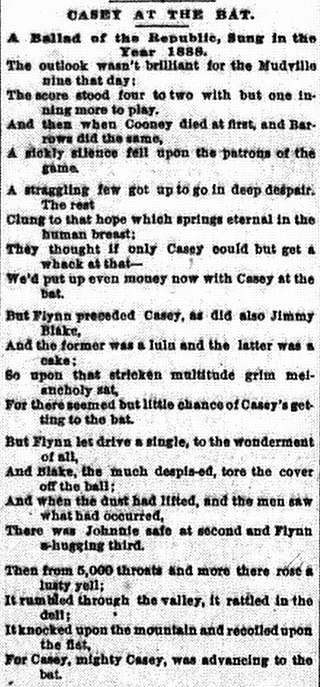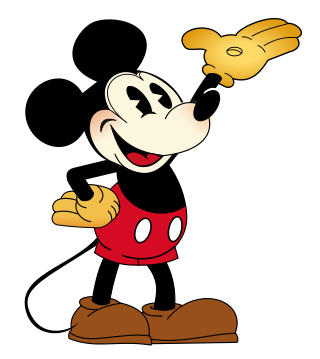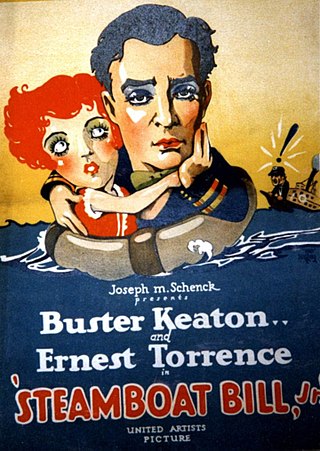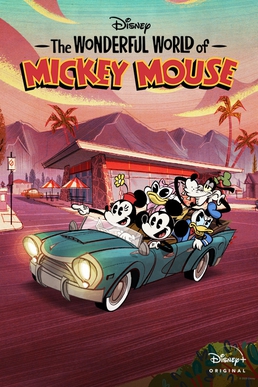
"Casey at the Bat: A Ballad of the Republic, Sung in the Year 1888" is a mock-heroic poem written in 1888 by Ernest Thayer. It was first published anonymously in The San Francisco Examiner on June 3, 1888, under the pen name "Phin", based on Thayer's college nickname, "Phinney". Featuring a dramatic narrative about a baseball game, the poem was later popularized by DeWolf Hopper in many vaudeville performances. It has become one of the best-known poems in American literature.

Mickey Mouse is an American cartoon character co-created in 1928 by Walt Disney and Ub Iwerks. The longtime icon and mascot of the Walt Disney Company, Mickey is an anthropomorphic mouse who typically wears red shorts, large shoes, and white gloves. He is often depicted alongside his girlfriend Minnie Mouse, his pet dog Pluto, his friends Donald Duck and Goofy and his nemesis Pete among others.

Pete is a cartoon character created by Walt Disney and Ub Iwerks of The Walt Disney Company. Pete is traditionally depicted as the villainous arch-nemesis of Mickey Mouse, and was made notorious for his repeated attempts to kidnap Minnie Mouse. Pete is the oldest continuing Disney character, having debuted in the cartoon Alice Solves the Puzzle in 1925. He originally bore the appearance of an anthropomorphic bear, but with the advent of Mickey in 1928, he was defined as a cat.

Minnie Mouse is an American cartoon character created by the Walt Disney Company. As the longtime sweetheart of Mickey Mouse, she is an anthropomorphic mouse with white gloves, a red or pink bow, blue polka-dotted dress, white bloomers and yellow low-heeled shoes occasionally with ribbons on them. The Mickey Mouse comic strip story "The Gleam" by Merrill De Maris and Floyd Gottfredson first gave her full name as Minerva Mouse, although this is seldom used.

The Mickey Mouse universe is a fictional shared universe which is the setting for stories involving Disney cartoon characters, including Mickey and Minnie Mouse, Donald and Daisy Duck, Pluto and Goofy as the primary members, and many other characters related to them, being most of them anthropomorphic animals. The universe originated from the Mickey Mouse animated short films produced by Disney starting in 1928, although its first consistent version was created by Floyd Gottfredson in the Mickey Mouse newspaper comic strip. Real-world versions also exist in Disneyland and Tokyo Disneyland, called Mickey's Toontown.

Steamboat Bill, Jr. is a 1928 silent comedy film starring Buster Keaton. Released by United Artists, the film is the final product of Keaton's independent production team and set of gag writers.

Runaway Brain is a 1995 American animated comedy horror short film produced by Walt Disney Feature Animation. Featuring Mickey Mouse and Minnie Mouse, the short centers on Mickey attempting to earn money to pay for an anniversary gift for Minnie. He responds to an advertisement to work for Doctor Frankenollie, only to find out that he is looking for a donor to switch brains with the monster he created. Featuring animation by animator Andreas Deja, it was first released in 1995 attached to North American theatrical showings of A Kid in King Arthur's Court and in 1996 attached to international theatrical showings of A Goofy Movie. It would be the final original Mickey Mouse theatrical animated short until Get a Horse! in 2013.
Walt Disney Records is an American record label of the Disney Music Group. The label releases soundtrack albums from The Walt Disney Company's motion picture studios, television series, theme parks, and traditional studio albums produced by its roster of pop, teen pop, and country artists.

Mickey Mouse Clubhouse is an American animated interactive television series for preschoolers. Produced by Disney Television Animation, the series was created by Disney veteran Bobs Gannaway. The series originally aired 125 episodes from May 5, 2006, to November 6, 2016, on the Disney Channel's preschool block, Playhouse Disney, making it the longest-running original series to air on the block. It received generally positive reviews from critics.

The Mickey Mouse Revue was an indoor audio-animatronic stage show at the Magic Kingdom and Tokyo Disneyland theme parks. It was one of the three original opening day attractions in Magic Kingdom's Fantasyland in 1971. After closing at Magic Kingdom in 1980, it was moved to Tokyo Disneyland for that park's opening in 1983 where it remained for 26 years before closing permanently in 2009.
The second wave of Walt Disney Treasures was released December 3, 2002. This was the final wave with the tin's individual number embossed on the tin.

Steamboat Willie is a 1928 American animated short film directed by Walt Disney and Ub Iwerks. It was produced in black and white by Walt Disney Studio and was released by Pat Powers, under the name of Celebrity Productions. The cartoon is considered the debut of both Mickey and Minnie Mouse, although both characters appeared several months earlier in a test screening of Plane Crazy. Steamboat Willie was the third of Mickey's films to be produced, but it was the first to be distributed, because Disney, having seen The Jazz Singer, had committed himself to produce one of the first fully synchronized sound cartoons.

The Music of Disney: A Legacy in Song is a 1992 three disc set of Disney songs spanning eight decades that were originally recorded from 1928 to 1991.

Get a Horse! is a 2013 American animated comedy short film produced by Walt Disney Animation Studios and directed by Lauren MacMullan. Combining black-and-white hand-drawn animation and color computer animation, the short features the characters of the late 1920s Mickey Mouse cartoons.

Once Upon a Mouse is a 1981 American theatrical featurette directed by Jerry Kramer and Gary Rocklen of Kramer/Rocklen Studios, produced in association with Walt Disney Productions. It was released on July 10, 1981 on a double bill with The Fox and the Hound.
"Mickey's 50" is a 1978 television special honouring the 50-year anniversary of the debut of Walt Disney's animated character Mickey Mouse. The show aired on NBC on November 19, 1978, one day after Mickey's official birthday, as a special 90-minute edition of The Wonderful World of Disney.

Traffic Troubles is a Mickey Mouse short animated film first released on March 7, 1931, as part of the Mickey Mouse film series. It was the twenty-sixth Mickey Mouse short to be produced, and the second of that year.

The Leighton Brothers was a vaudeville performance team consisting of brothers Frank Leighton and Bert Leighton. They also composed various songs, most notably "Steamboat Bill," the tune used in the Disney animated short, Steamboat Willie.

The Wonderful World of Mickey Mouse is an American animated television series produced by Disney Television Animation for Disney+. The series is a continuation and revival of the Emmy Award-winning 2013 Mickey Mouse shorts, uses the same style, and has many of the same cast and crew, with the exception of the late Russi Taylor, who was replaced by Kaitlyn Robrock in the role of Minnie Mouse. The series premiered on November 18, 2020 to coincide with Mickey's 92nd birthday. The animation is provided by Mercury Filmworks.

















